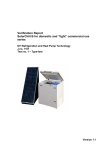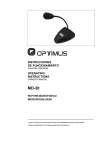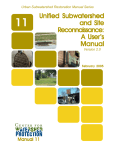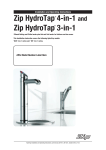Download Amana NAV-1 Washer User Manual
Transcript
R-410A REMOTE OUTDOOR UNIT USER’S INFORMATION MANUAL R C R Thank you for investing in our quality Comfort System. The air conditioner you have purchased is part of a Split System and has both indoor and outdoor components. With proper installation and maintenance, it should provide you with years of dependable service. Take time to familiarize yourself with the information concerning unit features, operation, and maintenance contained within this manual. Check the serial plate for model identification. Record this information on the last page of this booklet. Please read this User’s Manual carefully, and follow the instructions given. Keep it in a safe place for future reference. Your warranty certificate is supplied with this unit. Read it carefully and note what is covered. Keep it and a copy of the bill received from your dealer in a safe place for future reference. This can serve as proof of the date of installation. is a trademark of Maytag Corporation and is used under license to Goodman Company, L.P. All rights reserved. ® Part No. 10659207 Printed in USA Goodman Company, L.P. 1810 Wilson Parkway • Fayetteville, Tennessee 37334 www.amana-hac.com 2003-2004 Goodman Company, L.P. Effective: June 2004 ATTENTION INSTALLING PERSONNEL As a professional installer you have an obligation to know the product better than the customer. This includes all safety precautions and related items. Prior to actual installation, thoroughly familiarize yourself with this Manual. Pay special attention to all safety warnings. Often during installation or repair it is possible to place yourself in a position which is more hazardous than when the unit is in operation. Remember, it is your responsibility to install the product safely and to know it well enough to be able to instruct a customer in its safe use. Safety is a matter of common sense...a matter of thinking before acting. Most dealers have a list of specific good safety practices...follow them. The precautions listed in this Installation Manual are intended as supplemental to existing practices. However, if there is a direct conflict between existing practices and the content of this manual, the precautions listed here take precedence. Remember to leave this manual with the homeowner. Table of Contents Typical Thermostat Operation ................................................................ 3 General Information ................................................................................ 5 Electrical Power Supply.................................................................................... 5 Refrigerant ....................................................................................................... 5 Annual Maintenance ........................................................................................ 6 Routine Maintenance ....................................................................................... 6 Replace or Clean Indoor Filter ............................................................................ 6 Clean Outside Coil (Qualified Servicer only) ....................................................... 6 Compressor ........................................................................................................... 6 Motors ................................................................................................................... 6 IMPORTANT SYSTEM INFORMATION ......................................................... 10 2 Typical Thermostat Operation Your thermostat is the control center for your Split System. It is very important that the thermostat be located where it can best “sense” the average room temperature. It must not be located where it is exposed to hot or cold drafts or to hot or cold spots on the wall, such as those received from outside walls, walls with pipes inside, or from openings into the attic. Because of the wide variety of programmable thermostats available, we cannot describe how all of them work. However, a typical thermostat has two switches: a SYSTEM switch and a FAN switch. WARNING To avoid possible equipment damage, personal injury, fire or death, the following instructions must be observed regarding unit location, air requirements and operating procedures. The SYSTEM switch can include settings of HEAT, OFF, COOL, AUTO: EMERGENCY HEAT – EMERGENCY HEAT is only used with heat pumps. Emergency heat means the compressor (i.e., the outdoor unit) is turned off, and your backup source (if present) will provide heat when the temperatures in the room falls below the temperature selected. (No matter how warm the room becomes, cooling will not be provided.) The backup source is usually electricity, but it may be a gas or oil furnace. The EMERGENCY HEAT setting may be used if you suspect a problem exists with the heat provided by the compressor, but your dealer is not able to service it immediately. With some comfort systems, the EMERGENCY HEAT setting may also be used to provide a quicker warm-up of the room. Once the warm-up is completed, you should usually return the system switch to the HEAT or AUTO setting. If you leave the system switch in the EMERGENCY HEAT setting, it may increase your operating costs. HEAT – Your comfort system provides heat when the temperature in the room falls below the temperature selected. No matter how warm the room becomes, cooling will not be provided. OFF – Your comfort system will not provide heating or cooling, no matter how cold or hot the room becomes. COOL– Your comfort system provides cooling when the temperature in the room rises above the temperature selected. No matter how cold the room becomes, heat will not be provided. AUTO – Your comfort system will provide heat when the temperature in the room falls below the temperature selected, and will provide cooling when the temperature in the room rises above the temperature selected. With most of these thermostats, you will have a temperature range in which neither heating or cooling is being provided. The AUTO setting will help your building avoid temperature extremes, but it may increase your operating costs. Room Temperature Thermostat NOTE: Keeping your windows closed whenever the thermostat SYSTEM switch is in the HEAT, COOL or AUTO setting will keep operating costs down. The Fan switch may include settings of AUTO and ON: Cool/Heat Temperature Control Dials Fan Switch System Switch OFF Fan Switch AUTO COOL AUTO COOL ON HEAT AUTO HEAT ON OFF ON Cool/Heat Switch Action AUTO– The indoor fan is operating when heating or cooling is being provided. NOTE: With some comfort systems, the indoor fan may continue to run for a short time after the compressor shuts off. With most gas furnaces, the indoor fan will start a short time after the burners are lit, and will keep running for a short time after the burners shut off. When your comfort system is not heating or cooling, the fan will not run. None System only cools, fan cycles off and on. System only cools, fan runs all the time. System only heats, fan cycles off and on. System only heats, fan runs all the time. No heating or cooling, fan runs all the time. Typical Thermostat ON 3 – The indoor fan runs continuously. Typical Thermostat Operation IMPORTANT: Keep light bulbs and other heat sources away from the thermostat. Heat from these items may cause the thermostat to falsely register the temperature of the room as warm when in actuality it may be quite cold. CAUTION Do not exceed the set point limits preset at the factory. As shipped from the factory, your comfort system is designed to provide cooling only when the outdoor temperature is 55°F or higher. Exceeding these limits may result in severe equipment damage. Residential room thermostats must be exposed to the air in the room in order to accurately control room temperature. It must not be covered. Thermostats used in commercial buildings however can be covered if approved thermostat guards are used. If you need a thermostat guard for your commercial building, contact your dealer or another qualified servicer. In some commercial applications or in a few homes, you may need cooling indoors even when the outdoor temperature is less than 55°F. If you do, discuss it with your dealer before operating your comfort system during cool weather. Some comfort systems will include a programmable thermostat. If your system does not include a programmable thermostat, you may want to discuss it with your dealer. Programmable thermostats can automatically switch to a more economical temperature setting when your building is unoccupied or you are sleeping. Programmable thermostats automatically switch to a more comfortable temperature setting at the time you have previously selected. A programmable thermostat can reduce operating costs without substantially reducing comfort. In most homes, these limits will not cause problems. To avoid potential problems, you may want to remind children not to play with the thermostat. CAUTION Over adjusting or “jiggling” the thermostat switch will cause the compressor on the outdoor unit to turn on then off, then quickly on again. Eventually this will cause a blown fuse, a tripped circuit breaker, and/or a damaged compressor. Do not move the temperature selector on the thermostat for at least five minutes after the compressor has shut off. For more information on your thermostat, consult the literature that shipped with your thermostat. If you have read it and still have questions, contact your dealer. 4 General Information Electrical Power Supply Refrigerant Many outdoor units include a crankcase heater. This small heater warms the oil in the compressor for improved lubrication. Once the needed temperature has been reached, most of these heaters will shut off automatically. Your comfort system uses R-410A refrigerant. R-410A does not contain chlorine and will not harm the ozone layer in the atmosphere. It is classified as an HFC (Hydrofluorocarbon). The EPA has approved R-410A under its Significant Alternative Policy (SNAP) guidelines. R-410A is environmentally “friendly” as it does not harm the ozone layer in the atmosphere. R-410A systems are the recognized replacement for R-22 systems in residential applications. These heaters work effectively, but not rapidly. If your outdoor unit has a crankcase heater and the power has been disconnected from your outdoor unit for more than two hours, you must connect electrical power to the outdoor unit for at least four hours before setting the thermostat so as to cause the unit to come on. When your comfort system is operating properly, the refrigerant is contained within airtight passages. No refrigerant escapes into the atmosphere during normal operation. Not all outdoor units have crankcase heaters. If you are not certain whether yours does or not, contact your dealer. If your outdoor air conditioning (not heat pump) unit does have a crankcase heater, you may wish to shut it off in the fall after cooling season is completely over. To do this, simply open the disconnect switch which is near the outdoor unit, or turn the proper circuit breaker at the electrical panel to the OFF position. This could save you a small amount of your winter electrical bills. If you choose to do this, remember - a four hour warm-up period with the electrical power connected is necessary before running the air conditioner again in the spring. If you forget this warm-up period, you run the risk of severe equipment damage. When repair or replacement of your comfort system becomes necessary, it is essential that you hire a qualified servicer to perform the work. A qualified servicer will have the tools and training necessary to ensure that EPA regulations are followed. U.S. residents who ignore or intentionally violate the EPA regulations are in violation of the law, and may be subject to fines or other penalties. 5 Maintenance Annual Maintenance CLEAN OUTSIDE COIL (QUALIFIED SERVICER ONLY) We strongly recommends your unit be given an annual maintenance checkup by a qualified servicer. Your unit should be inspected by a qualified installer or service agency at least twice a year. This check should be performed before the heating and cooling seasons begin. This will ensure that your unit operates at maximum efficiency. Particular attention should be paid to the following items. Repair as necessary. WARNING To avoid personal injury or death due to electrical shock, disconnect the electrical power before cleaning the coil(s). • Check physical support of the unit. Ensure it is sound without any sagging, cracks, or gaps, around the base. DISCONNECT ALL ELECTRICAL POWER TO THE INDOOR AIRHANDLER OR FURNACE BEFORE REMOVING ACCESS PANELS TO PERFORM MAINTENANCE. Disconnect power to both the indoor and any outdoor units. NOTE: THERE MAY BE MORE THAN ONE ELECTRICAL DISCONNECT SWITCH. • Check for obvious signs of deterioration of the unit. • Check electrical connections for tightness and/or corrosion. Check wires for damage. ALTHOUGH SPECIAL CARE HAS BEEN TAKEN TO MINIMIZE SHARP EDGES IN THE CONSTRUCTION OF YOUR UNIT, BE EXTREMELY CAREFUL WHEN HANDLING PARTS OR REACHING INTO THE UNIT. • Check that filters are clean and in the proper placement in the unit or duct system. Routine Maintenance Air must be able to flow through the outdoor unit of your comfort system. Do not construct a fence near the unit or build a deck or patio over the unit without first discussing your plans with your dealer or other qualified servicer. Restricted airflow could lead to poor operation and/or severe equipment damage. REPLACE OR CLEAN INDOOR FILTER IMPORTANT NOTE: Never operate unit without a filter installed as dust and lint will build up on internal parts resulting in loss of efficiency, equipment damage and possible fire. Likewise, it is important to keep the outdoor coil clean. Dirt, leaves, or debris could also restrict the airflow. If cleaning of the outdoor coil becomes necessary, hire a qualified servicer. Inexperienced people could easily puncture the copper tubing in the coil. Even a small hole in the tubing could eventually cause a large loss of refrigerant. Loss of refrigerant can cause poor operation and/or severe equipment damage. An indoor air filter must be used with your comfort system. A properly maintained filter will keep the indoor coil of your comfort system clean. A dirty coil could cause poor operation and/or severe equipment damage. Your air filter or filters could be located in your furnace, in a blower unit, or in “filter grilles” in your ceiling or walls. The installer of your air conditioner or heat pump can tell you where your filter(s) are, and how to clean or replace them. Do not use a condensing unit cover to “protect” the outdoor unit during the winter, unless you first discuss it with your dealer. Any cover used must include “breathable” fabric to avoid moisture buildup. Check your filter(s) at least once a month. When they are dirty, clean or replace them. You may want to ask your dealer about high efficiency filters. High efficiency filters are available in both electronic and non-electronic types. These filters can do a better job of catching small airborne particles. COMPRESSOR The compressor motor is hermetically sealed and does not require additional oiling. MOTORS Indoor and outdoor fan motors are permanently lubricated and do not require addtional oiling. 6 Before Calling Your Servicer There are several built-in safety features that may automatically shut off the unit under abnormal operating conditions. If your system does not operate normally, take time to perform the following checks before requesting service. A couple of simple checks may allow you to avoid a service call. If the following steps do not resolve the problem, contact a qualified servicer for further troubleshooting and/or repairs. Do not attempt troubleshooting beyond that which is outlined below. • Check the thermostat to confirm that it is properly set. • Wait 15 minutes. Some devices in the outdoor unit or in programmable thermostats will prevent compressor operation for awhile, and then reset automatically. Also, some power companies will install devices which shut off air conditioners for several minutes on hot days. If you wait several minutes, the unit may begin operation on its own. • Check the electrical panel to see if any circuit breakers have tripped or fuses have failed. If they have, you may reset the circuit breaker(s) or replace the fuse(s) once without calling a servicer. CAUTION To avoid the risk of fire or equipment damage, install the same amperage circuit breaker or fuse as you are replacing. If the circuit breaker or fuse should open again within thirty days, contact a qualified servicer to correct the problem. If you repeatedly reset the breaker or replace the fuse without having the problem corrected, you run the risk of severe equipment damage. • Check the disconnect switch near the indoor furnace or blower to confirm that it is closed. • Check the outdoor unit to confirm that it has not been covered on the sides or the top. If it has been covered by a large object that you can easily remove, you may do so without calling a servicer. If it is covered with dirt or debris, call a qualified servicer to clean it. • Check the indoor air inlets and outlets to confirm that they are not blocked by rugs, curtains, or other objects; or have not been accidentally closed. If air cannot get into a room, the room will not be comfortable. • If airflow through all the air outlets seems low, check the filter. If it is dirty, clean or replace it. 7 Safety Labels NOTE: If safety labels are missing or illegible, contact the installing dealer or our Customer Service Department for ordering information. WARNING WARNING R is k o f e le c tr ic s h o c k o r d e a th . D i s c o n n e c t r e m o te e l e c t r i c p o w e r s u p p ly o r s u p p l ie s b e f o r e s e r v i c i n g . T h i s c o m p a r t m e n t m u s t b e c lo s e d e x c e p t w h e n s e r v i c in g . HAZARDOUS MOVING PARTS AVERTISSEMENT Fan blades may start rotating automatically. Danger de choc électrique ou de mort. Débrancher toute boite á fusibles avant l'entretien. Ce compartment doit rester ferme, sauf pour l'entretien. Do not apply power to this appliance or compressor if the compressor terminal cover has been removed or is not firmly in place. AVERTISSEMENT PIÈCES MOBILES DANGEREUSES Les ailes du ventilateur peuvent commencer à tourner automatiquement. N'applique pas le pouvoir á cet appareil ou compressor si la borne couvre a été enlevée ou n'est pas fermement dans endroit. 20183701 WARNING FIRE AND/OR SEVERE PERSONAL INJURY HAZARD. REFRIGERANT MUST BE REMOVED FROM BOTH THE LOW AND HIGH PRESSURE SIDES OF THE SYSTEM BEFORE HEAT IS APPLIED. CARBON MONOXIDE POISONING HAZARD Specia l Wa rnin g forforInstall ation of Fu rn aces or or AirAir Hand lin g UniUnits ts in in Special Warning Installation of Furnace Handling Enclo sed Areas asasGaGarages, rage s, Utility RoRooms oms o r Pa ng AreaAreas s Enclosed Areassuch such Utility or rki Parking Carbo n monoxide pro ducin g device s (su ch a s a n automob ile , space Carbon monoxide producing an automobile, space hea ter, gas wa ter he ate r, etc.)devices sho uld (such n ot beas o pera ted in enclosed are as heater, heater, etc.) not in enclosed su ch asgas unvewater ntilated g arage s, should utility roo msbeoroperated pa rking are as becau areas se of such as unventilated garages, utility rooms or parking areas because of th e dang er of carb on mono xide (CO) poiso nin g resultin g fro m the exh aust the danger of carbon monoxide (CO) poisoning resulting from the exhaust emissio ns. IfIfaafurna ce ororaair ir han dler isisinstalled a such emissions. furnace handler installedi ninan anenclosed enclosedare area such as aa ggarage, arag e, utility u tility ro om oorr pparking arking aarea rea and rbon mon oxide pproducing rodu cing as room and aa ca carbon monoxide device iiss ooperated pera ted the rein, th ere must e aadequate, deq uate, direct direct outside outside device therein, there must bbe ventilation. ve ntila ti on. Th is ve ntila tio n is nece ssa ry to avoid th e d ang er of CO poisonin g which This ventilation necessary CO which ca n occur if a caisrbon mon oxidtoe avoid p rodu the cingdanger de vice of con tinpoisoning ues to o pera te in can occur if a carbon monoxide producing device continues to operate in th e enclo sed area . Ca rbon mono xide e mission s ca n b e (re)circulated the enclosed area. Carbon monoxide emissions can be (re)circulated th ro ugh out th e structure e fufurnace rnace ororair ndler isisooperating pera tin g ininanany y throughout the structureififththe airha handler mode. mode. CO can can cause cause se ri ous illne ss inincluding clud ing pepermanent rmanen t brabrain in dama ge or dea th . CO serious illness damage or death. B10259-216 B10259-216 8 10466 6-01 Any Questions? Most questions can be answered by your local dealer. If you need further information regarding the operation, maintenance, or service of your unit, contact your dealer. If you have other matters that cannot be resolved locally, or you need additional information regarding other heating and cooling products offered by us - please call: CONSUMER INFORMATION LINE TOLL FREE 1-877-254-4729 (U.S. only) email us at: [email protected] fax us at: (731) 856-1821 (Not a technical assistance line for dealers.) Outside the U.S., call 1-713-861-2500. (Not a technical assistance line for dealers.) Your telephone company will bill you for the call. Ask your participating dealer about our extended service plan. It adds to the strong warranty with additional parts and labor coverage. 9 Model Information IMPORTANT SYSTEM INFORMATION Please write the Model number, Manufacturing number, and Serial number of your unit. MODEL MFG PIC SERIAL# CRANKCASE HEATER YES NO Record installer information below: Installing Company: _____________________________ Telephone Number: _____________________________ Installation Date: _______________________________ Space has been provided below to record the Model, Manufacturing, and Serial numbers of the indoor air handler, “A” coil, or accessory equipment installed with your unit. Recording this information here will assist you in the future should service be required. (Note: Some accessories will not have serial numbers.) MODEL _____________________________________ MFG _______________________________________ SERIAL# ____________________________________ MODEL _____________________________________ MFG _______________________________________ SERIAL# ____________________________________ MODEL _____________________________________ MFG _______________________________________ SERIAL# ____________________________________ 2003-2004 Goodman Company, L.P. 10 Effective: June 2004















